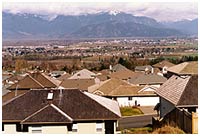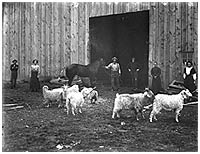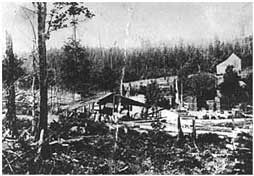
Fruit growing was popular at Promontory and George Thornton's fruit orchard was significant to the province of British Columbia. Mr. Thornton, who arrived in Promontory in 1891, worked for the Provincial Government and prepared fruit and vegetable specimens for exhibits at many fairs. These professional exhibits were assembled in large glass containers and involved careful chemical preparation that was prepared in the acid house located on his property. These exhibits promoted British Columbia farmlands by allowing visitors at these fairs to see, in preserved form, the quality and abundance of the province.
The Coathams arrived in 1900 and developed a family farm from forty acres of heavily wooded land that required clearing. Step by step, the clearings were planted with several types of fruit trees including early and winter apples, pears, plums, and several varieties of cherries. Active in participating in exhibition at agricultural fairs several of the Coatham's fruit presentations won prizes at the New Westminster Fair.
Perched atop Promontory Heights, sits the one-room Promontory School. Built in 1909 on land donated by Promontory settler Ed Thornton, the school was closed in 1941, but remains standing on its original site. Ninety years later the former school now serves as the home for the Hobby Hill Parent Participation Pre-school.
In September 1956, the Township of Chilliwhack signed a 20-year lease, permitting the use of the school property by the Promontory Heights Women's Institute. The institute, originally formed in April 1952, was part of the Hopeline District. In 1971, the Women's Institute began a restoration project, with the goal of maintaining the original design and floor plan. Renovations to the former Promontory School were completed in 1974.
With its panoramic view of the Chilliwack Valley, the former Promontory School has been designated a Municipal Heritage site, and serves as a fine local example of the one room school buildings so vital to British Columbia's rural past.
A few mills were located in Promontory and timber in the area consisted of heavy growth that was certainly easy to log. Orion Bowman operated the longest running mill operations in the area and established, in 1908, his first mill on Upper Promontory Road. In 1912, mill operations were expanded and a shingle mill was added. This new venture was relocated at the foot of Promontory Road and once the Promontory fruit orchards began bearing fruit the Bowman and Sons' mill started to cut wood for the manufacture of fruit boxes.
Much of the early logging at Promontory was conducted using horses, wagons and skid rows. However, after Bowmans', constructed their second mill site a narrow gauge railway from the mill was built that headed four and a half miles towards the east. Another line headed in a westerly direction and another was later constructed on a southerly route. Rail lines were eventually abandoned as trucks with hard rubber wheels took over logging operations.

Promontory - Modern, 2000

George Israel Thornton holding horse, surrounded by family members and several angora goats, ca. 1890s. P3684.


The original Orion Bowman mill, located on the Ed Thornton property on Teskey Road, ca. 1906-1907. P2106.